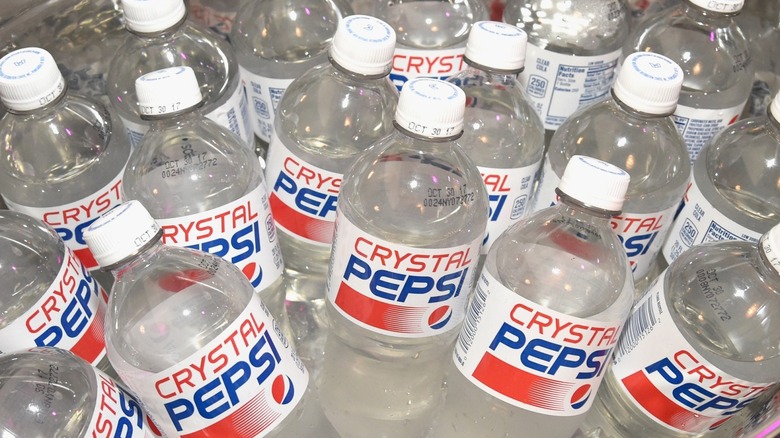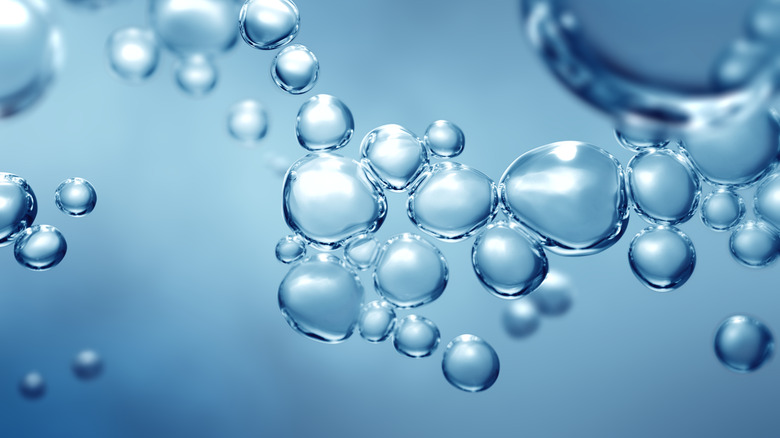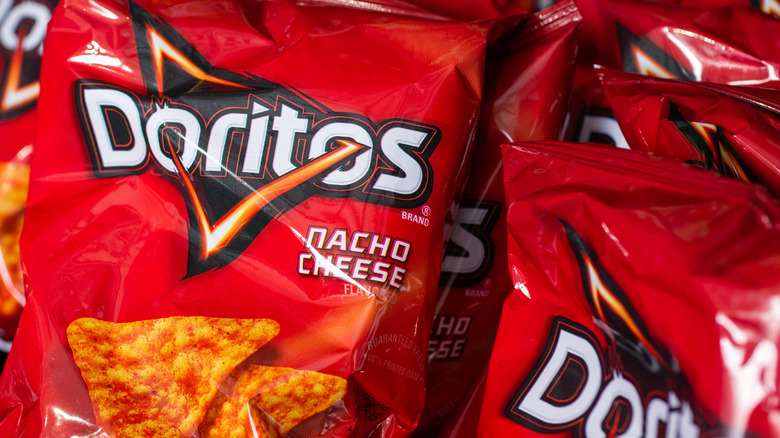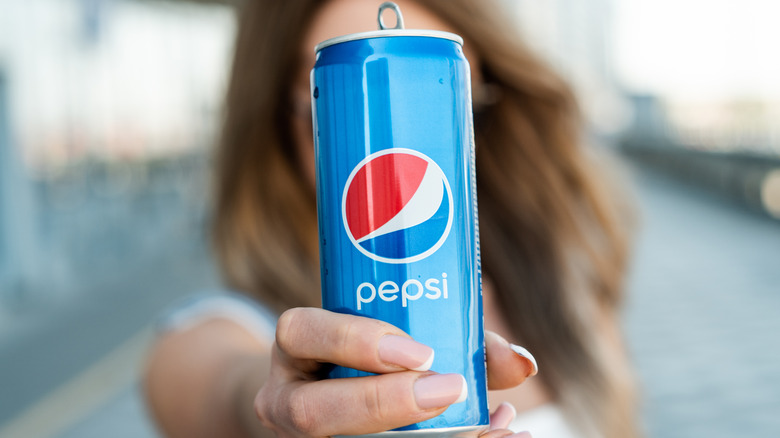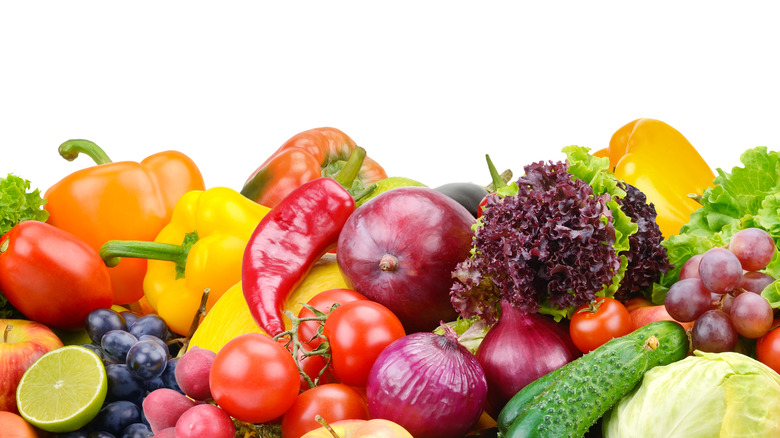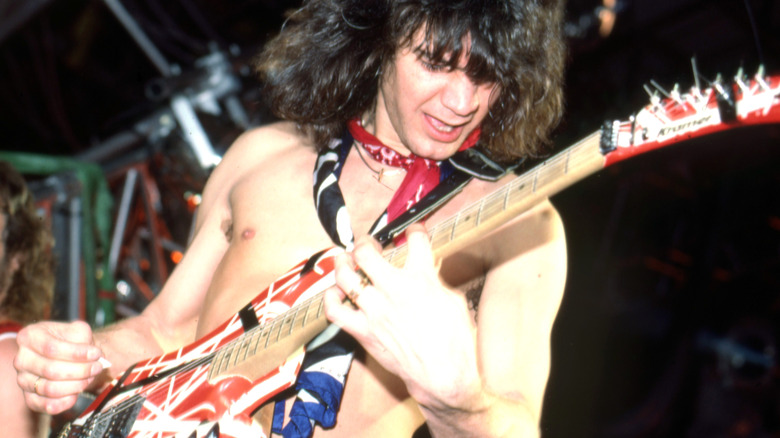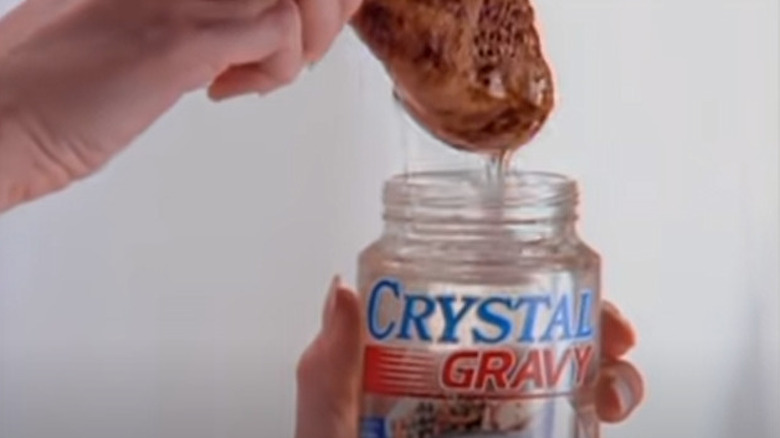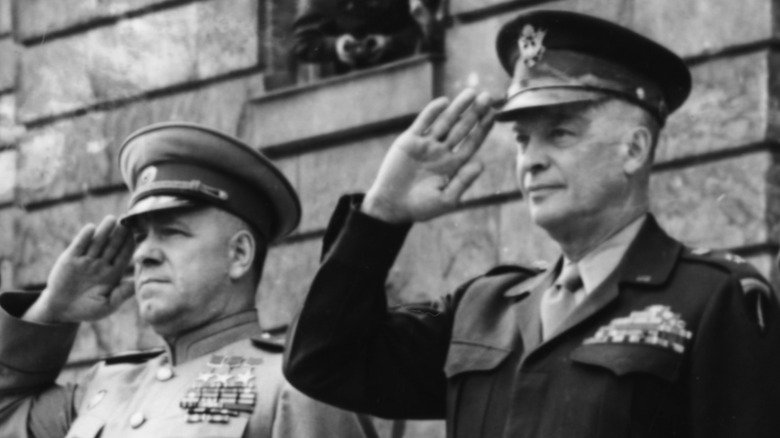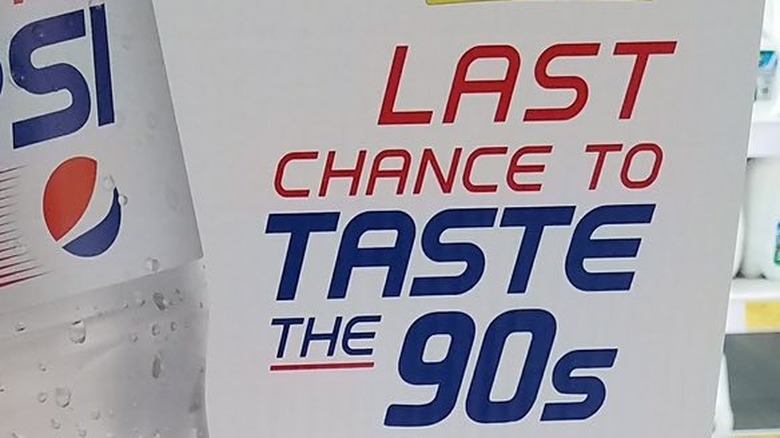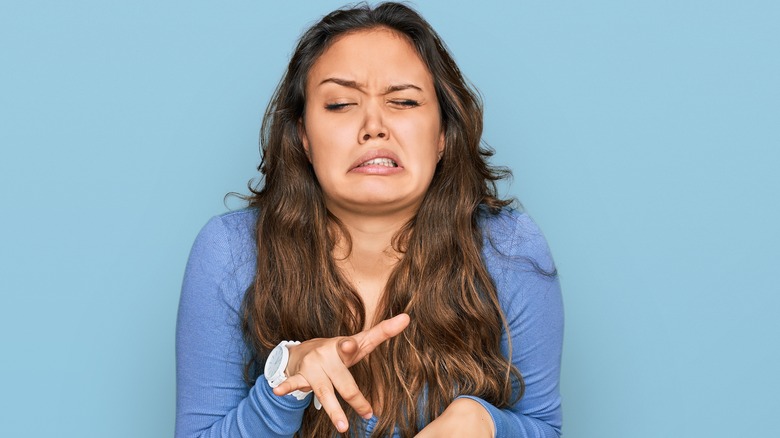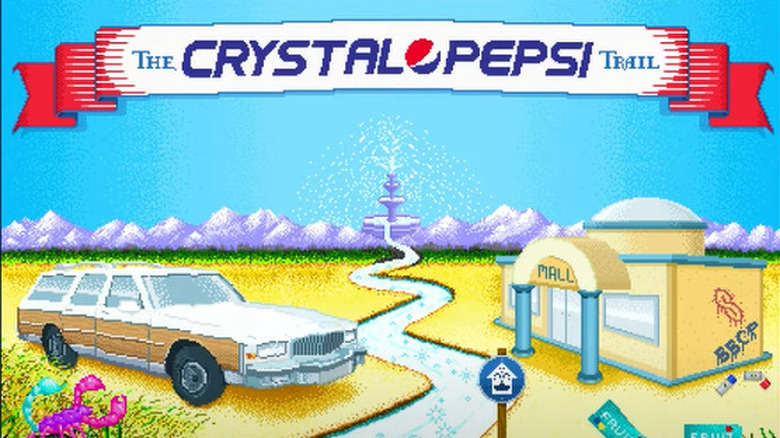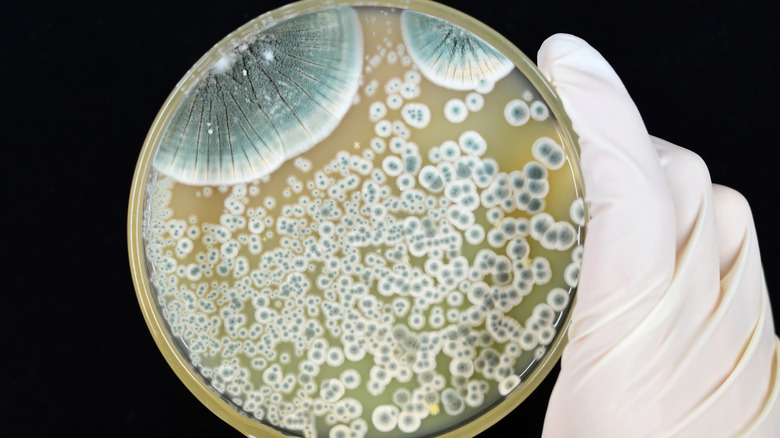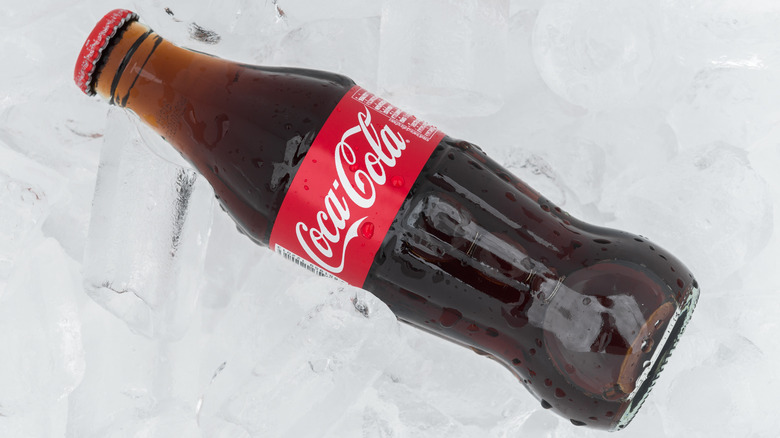The Untold Truth Of Crystal Pepsi
We're living in a world of peak 1990s nostalgia. Virtually everything that millennials and Gen X-ers grew up with has reemerged, from bizarre fashion trends (mom jeans, anyone?) to unhealthy kid's snacks, like Dunkaroos. But nostalgia has a funny way of playing tricks on your mind. The rose-colored tint of wistful remembrance makes it easy to get swept up in a memory, making you reconsider notions that previously seemed stranger than fiction.
For instance: was Crystal Pepsi actually good?
If you weren't lucky enough to live through the madness that was the pre-internet days of the early '90s, recent events may have you believing that Crystal Pepsi was the greatest thing since sliced bread. "You've never seen a taste like this," the product's slogan declared, and if nothing else? That was certainly true. Yet today, in 2022, the question of whether or not Crystal Pepsi lived up to the hype the first time around -– which it, emphatically, did not -– is irrelevant. Because like all things from the '90s, Crystal Pepsi has greatly benefitted from revisionist history.
But what do you actually know about the world's most famous clear cola? While the existence of Crystal Pepsi may be well-known, the true story behind the product may surprise you. So grab your fanny pack, Slim Jims, and Starter jacket, as we take a deep dive into this quintessential '90s beverage.
Crystal Pepsi was an attempt to cash in on the early '90s clear craze
The late '80s and early '90s saw an explosion in items being marketed as "pure" or "clear." The clear craze of the day caused countless companies to embrace the fad, from the introduction of the clear alcoholic beverage, Zima, to the relentless touting of Ivory soap as "99 44/100% PURE." Even Amoco Oil tried to get in on the trend, advertising "crystal clear Amoco ultimate" fuel as superior to other brands (specious claims that eventually led to charges of misleading consumers by the Federal Trade Commission).
Everyone was eager to get in on the trend, including David Novak, the then-COO of Pepsi Cola, who spearheaded the creation of Crystal Pepsi in 1992. The former Pepsi-Cola and Yum! Brands executive recognized the clear rise of colorless and decaffeinated beverage sales (via Thrillist). And, driven by plateaued sales for classic Pepsi, he thought to himself: "Why not make a Pepsi that's both?"
According to Business Insider, Novak believed consumers would be drawn to a clear cola because they'd find it both healthier and more refreshing. However, as Crystal Pepsi was neither healthy nor -– according to soda drinkers of the day –- very refreshing, consumers weren't buying what the company was selling, leading to the soda's demise within two years of release.
It was developed by the same food scientist behind Nacho Cheese Doritos
While David Novak was responsible for its conception, the actual process of creating Crystal Pepsi was the work of renowned food scientist, Dr. Surinder Kumar. Known as one of the inventors of the Nacho Cheese Dorito flavor, Dr. Kumar was the head of Research and Development for Pepsi in 1992, and was tasked with a challenge he initially deemed infeasible: developing a recipe for a clear cola that tasted exactly like the regular, brown-colored alternative. Pepsi Cola executives had faith in Kumar's ability to pull it off, though he was less certain, noting "there are laws of physics and chemistry you can't change," according to Thrillist.
Finding suitable substitutes for the flavoring agents and chemicals that make Pepsi caramel-colored posed a massive challenge. But Kumar plowed forward with his work, determined to solve the Rubik's cube that would lead to Crystal Pepsi. After months of trial-and-error, he was able to do so, formulating a unique combination of sugars and salts to replicate the taste ... including a mysterious substitute for the caramel flavoring that, as of 2020, still remained unknown to the general public.
Dr. Kumar has had a prolific career in food science beyond his creation of Crystal Pepsi. He's also worked for such companies as Quaker Oats, Wrigley, and Bristol Myers, before co-founding the modern bakery, TruEats, with his son in 2021.
It didn't taste quite like regular Pepsi
When you consider the entire marketing campaign surrounding Crystal Pepsi was built on the notion that it tasted precisely like the real thing, any deviation from the classic Pepsi flavor was unacceptable. Yet, somehow, despite investing millions of dollars in its development and marketing, this ended up being the case, as Crystal Pepsi never quite tasted "like Pepsi," according to Novak (via Business Insider).
This outcome may have been unavoidable, particularly when you consider Dr. Kumar was never given the actual recipe for regular Pepsi when creating the clear alternative, according to Thrillist. This made the food scientist's already-daunting assignment that much more difficult, because how can you replicate the exact flavor of a product if you don't know how the product is made in the first place? The challenge of creating Crystal Pepsi without the Pepsi recipe was akin to developing a meatless fried chicken alternative for KFC without knowing the famed 11 herbs and spices (making Dr. Kumar's accomplishment that much more impressive).
Pepsi executives were warned about Crystal Pepsi's slightly-altered flavor before its launch -– they just didn't care to listen. The rush to get Crystal Pepsi in stores nationwide blinded them to the reality that this would doom the product from the start, and may have been chiefly responsible for the beverage's rapid rise and fall from 1992 to 1994.
It was not a healthy or natural beverage as ads implied
Perhaps the main driving force for the clear and pure product trend that dominated the early '90s was the implicit belief that the items marketed as such were actually healthier. Understanding this, Pepsi leaned into this assumption with its marketing strategy for Crystal Pepsi, beginning with the absurd Super Bowl commercial that first announced its arrival.
Crystal Pepsi was, in fact, caffeine and preservative-free (with the infamous commercial declaring "only wildlife needs preservatives," and "right now will do just fine without caffeine"). But the idea that Crystal Pepsi was, in any way, a pure, natural, or healthy beverage was untrue. Considering the amount of chemical engineering that went into creating Crystal Pepsi in the first place, the notion that it was a more natural product was patently false. Not only that, but it was loaded with high fructose corn syrup, just like any other regular soda (via Business Insider).
Not everyone at Pepsi was onboard with the deceptive nature of Crystal Pepsi's marketing strategy. In particular, Dr. Kumar was uncomfortable with the plan, believing "it was misleading," according to Thrillist. He expressed his displeasure at the time, telling Pepsi executives that "if we want to market it as 'pure' and 'natural,' then the ingredients need to reflect that."
Van Halen wasn't happy with Crystal Pepsi using their song
It may not be as intriguing as the debate surrounding which Van Halen lead singer was the best (it's David Lee Roth, folks, hands down), but it's still a question worth asking: how did Van Halen feel about having their song, "Right Now," being used in the iconic Crystal Pepsi ad that announced its arrival during the Super Bowl? Not great, as it turns out.
But, according to the late Eddie Van Halen, the band didn't have much of a choice. "The only reason we gave Pepsi the music was because they were going to use the song anyway," he stated (via Guitar World), recognizing the beverage maker had decided to copy the entire aesthetic of their award-winning music video for "Right Now" one way or another. The band understood that if a cover of their song played during the commercial, rather than their own version, they wouldn't be paid.
"I'm not going to say, 'No, go ahead, rip us off," the virtuoso guitarist noted, "'and keep the money, too!'" So the legendary band made the business decision to "get the money," and begrudgingly signed off on the song's usage for the widely seen, and widely remembered, Crystal Pepsi commercial.
The iconic Super Bowl commercial was immortalized by SNL
The instantly iconic Super Bowl commercial that announced Crystal Pepsi's arrival remained closely associated with the soda throughout its initial release. The melodramatic, self-serious advertisement was rife with ridiculous imagery, essentially declaring that Crystal Pepsi was the future of humanity through faux-insightful text scrolling across the screen. The commercial was so absurd –- and Crystal Pepsi itself was so reviled -– that it was begging to be parodied. And, in late 1993, during "Saturday Night Live's" 19th season, the world was treated to the instant-classic sketch, "Crystal Gravy."
Reimagining Crystal Pepsi as a clear, viscous alternative to brown gravy, the sketch plays with viewers' expectations by pitch-perfectly recreating the commercial, complete with a fake song titled, "It's Now." Pepsi executives didn't enjoy the sketch -– "they were basically saying [Crystal Pepsi] didn't taste good," said David Novak (via Thrillist) -– but it struck a chord with viewers.
Between Julia Sweeny dipping a drumstick into a jar of the clear goo, and the late comedic genius, Phil Hartman, savoring a piece of turkey doused in the titular sauce, the sketch seemed to signal the world was ready to move on from Crystal Pepsi. And, within months of its debut, Pepsi obliged, quietly discontinuing the beverage in early 1994.
It wasn't the first clear cola produced
Despite being the world's most well-known variety, Crystal Pepsi wasn't the first clear cola to be created. In fact, according to Russia Beyond, five decades before Crystal Pepsi was even conceived, Coca-Cola produced their own version, called White Coke, for a single person: Russian general Georgy Zhukov.
The strong association between classic Coke, the United States, and capitalism made the beverage's consumption in communist U.S.S.R. strongly discouraged. But after being introduced to the sugary soda during World War II –- by fellow allied commander, and future U.S. president, Dwight Eisenhower –- general Zhukov developed an addictive love for the sweet beverage (via BBC). Unable to dissipate his cravings, Zhukov asked if a clear version of the famous cola, that resembled vodka, could be developed to elude detection back in Russia. And, with an assist from the U.S. government, White Coke was created.
While the clear Coke wasn't mass-produced, and only included the 50 crates shipped to General Zhukov in 1946, its legacy lives on in history. And, unfortunately for Pepsi, White Coke's existence stands as just one more area where it has to settle for coming in second place to Coke.
Fan campaigns and '90s nostalgia have led to re-releases
The universal disdain for Crystal Pepsi during its initial run was undeniable. But, like a wide variety of '90s foods, the passage of time has led to a nostalgic reevaluation of many products, with Crystal Pepsi one of the main beneficiaries of this trend. The desire to revive all things '90s -– both good and bad, loved and hated -– has spurred vocal fan campaigns for previously abandoned items, like Crystal Pepsi and Surge (via Food & Wine).
Since its original demise, Crystal Pepsi has been revived on three occasions -– largely thanks to professional eater Kevin Strahle, or L.A. Beast. After a video of him chugging a 20-year-old bottle of Crystal Pepsi went viral in 2013, Strahle spearheaded a Twitter campaign, #BringBackCrystalPepsi, urging Pepsi to, well, bring back the once-hated beverage. After two years, and a Change.org petition that garnered over 38,000 signatures, Pepsi granted the super fan's wish (which included sending Strahle a personalized letter).
A successful fan giveaway in 2015 led to a limited-time re-release in late 2016 (via Forbes), as well as another fan contest in early 2022. While the future of Crystal Pepsi is unclear –- no pun intended -– if the past is any indication? You should never say never when it comes to the infamous clear cola.
Being clear may have unintentionally turned off consumers
The fact that clear cola is such a novelty isn't a random coincidence: it's the result of marketing campaigns that have trained consumers, for decades, to associate caramel-colored soda with cola (via LiveScience). Like so many things, the color we associate with cola is a direct result of social engineering that ingrained the concept into our brains. And while the idea of a clear cola may have seemed enticing in theory, encountering it in reality may have been too much for some to handle.
Given our brains are primed to distrust the notion that any clear soda can actually taste like regular cola, Crystal Pepsi may have been doomed from the start. While humans are inherently attracted to unique items that differ from our expectations, there's a limit to how much weirdness we can take. In fact, when something veers too far from our preconceived expectations, it can trigger an unbearable wave of discomfort and apprehension (via The Conversation).
There's no denying that consumers were initially curious about a clear cola; it just appears that curiosity may have killed the cat in this instance. In other words, Crystal Pepsi may have simply been too bizarre, and too out of the ordinary, to ever become more than an unusual anomaly.
Memorable promotions have always been part of its brand
Over-the-top marketing promotions have always been a large part of Crystal Pepsi's mystique, beginning with the decision to blatantly rip off a famous Van Halen music video for its Super Bowl commercial. Frankly, this advertising philosophy, coupled with the choice to take inspiration from already-popular pieces of pop culture, has been Crystal Pepsi's modus operandi since its original creation.
These instantly memorable promotions have helped Crystal Pepsi stand the test of time, and led Pepsi to wholeheartedly embrace the '90s nostalgia that's spurred the public's continual interest. In 2016, in conjunction with Crystal Pepsi's brief return, the beverage company released its own version of the famous CD-ROM video game, "Oregon Trail," that parodied the beloved '90s relic: "The Crystal Pepsi Trail."
This continued with the latest re-release in early 2022, which celebrated the 30th anniversary of Crystal Pepsi's original launch. That January, Pepsi held a social media contest, #ShowUsYour90s, encouraging contestants to post pictures of themselves from the 1990s. The company then chose 300 lucky winners, each of whom received a six-pack of the clear cola as a prize.
Its lack of color and clear bottles made it prone to quick spoilage
One of the bigger challenges in the original creation of Crystal Pepsi was overcoming clear soda's tendency to quickly spoil when exposed to light. "Colas are brown for a good reason," Dr. Kumar has said (via Thrillist), and overcoming the many microbes that can spoil soda, such as various yeasts and bacterias (according to ScienceDirect), was immensely difficult.
While other clear sodas, like Fresca, are sold in green bottles to ameliorate this issue, Novak insisted Crystal Pepsi be sold in clear bottles to highlight the soda's (lack of) color -– upping the ante for Kumar's work. But the fact that Kumar was concerned with avoiding a product that "smells and tastes like shoe polish" after sitting in the sun didn't matter to the company. "'You're a food scientist,'" Pepsi executives told him at the time, "'figure it out.'"
With the company's unyielding desire to buck the trend of other clear soda's packaging, Dr. Kumar dutifully plugged away in his work. But, in time, his fears were proven right, as reports of Crystal Pepsi being left in "direct sunlight" at stores were quickly followed by customer complaints.
Coke released Tab Clear hoping for mutually assured destruction with Crystal Pepsi
The battle for cola supremacy, between Pepsi and Coke, has been raging for decades, and the introduction of Crystal Pepsi led to one of the most surprising developments of the long rivalry. After Crystal Pepsi earned a strong 1% market share during its early, initial release (via LiveScience), Coca-Cola was inclined to respond in some way. But rather than develop their own clear cola to truly compete against Crystal Pepsi, the company released Tab Clear –- expecting the beverage to fail, and bring its competition down with it.
Convinced consumers were turned off by diet sodas, Coke introduced Tab Clear with no intention or desire to succeed. In fact, its sole purpose was to destroy the market for Crystal Pepsi, by convincing customers that the clear cola-like Tab Clear, which was sold next to Crystal Pepsi at stores –- was also a diet soda. "It was a suicidal mission from day one," said Sergio Zyman, the Chief Marketing Officer for Coca-Cola in 1992 (via the book, "Killing Giants: 10 Strategies to Topple the Goliath of Your Industry").
Simply put, Coca-Cola executives didn't care if Tab Clear crashed and burned. Because, as Zyman explained, "Pepsi spent an enormous amount of money on the brand, and ... we killed it."
